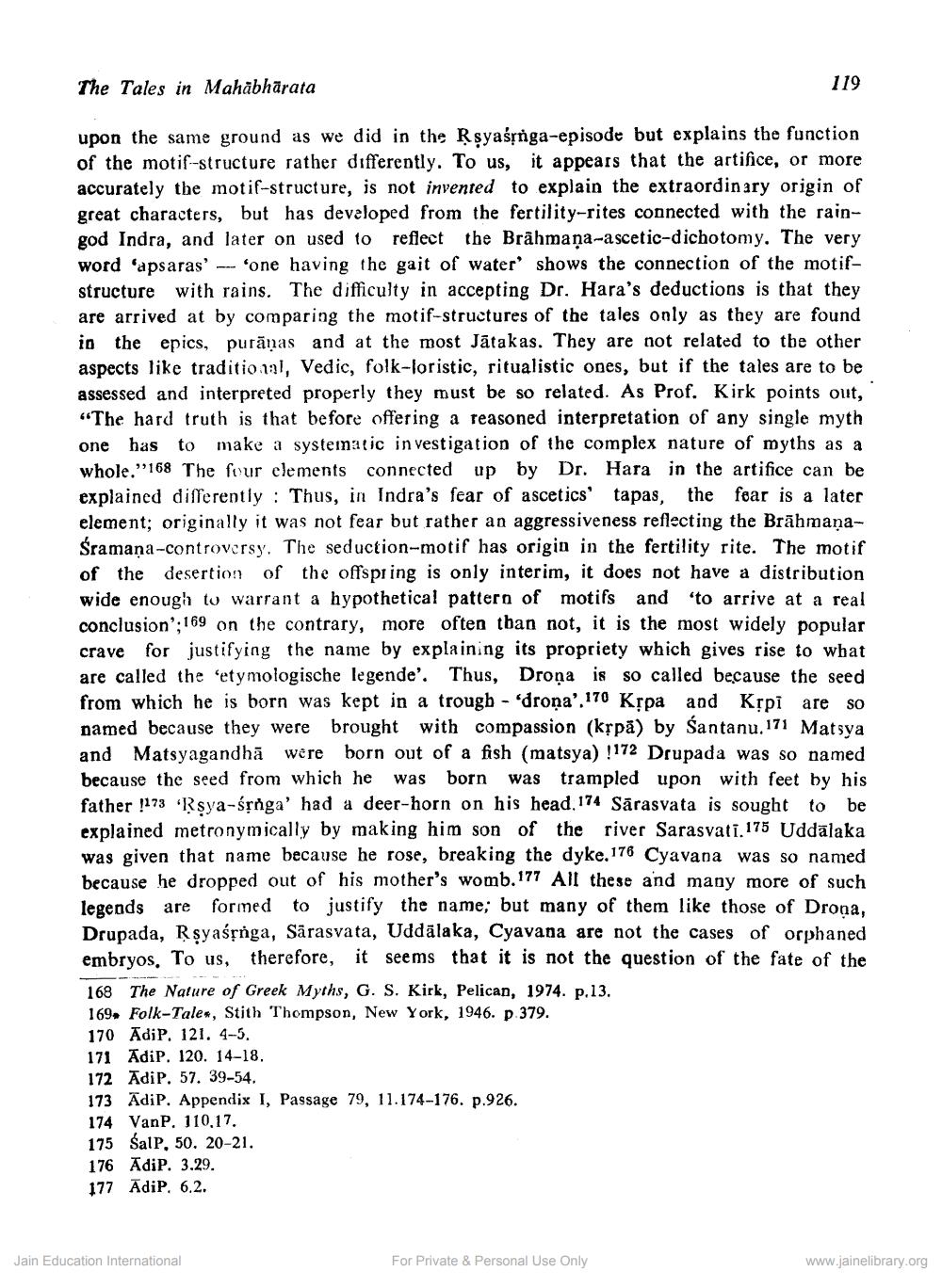________________
The Tales in Mahabharata
119
upon the same ground as we did in the Rşyaśặnga-episode but explains the function of the motif-structure rather differently. To us, it appears that the artifice, or more accurately the motif-structure, is not invented to explain the extraordinary origin of great characters, but has developed from the fertility-rites connected with the raingod Indra, and later on used to reflect the Brähmaņa-ascetic-dichotomy. The very word 'apsaras' -- 'one having the gait of water shows the connection of the motifstructure with rains. The difficulty in accepting Dr. Hara's deductions is that they are arrived at by comparing the motif-structures of the tales only as they are found in the epics, purāṇas and at the most Jātakas. They are not related to the other aspects like traditional, Vedic, folk-loristic, ritualistic ones, but if the tales are to be assessed and interpreted properly they must be so related. As Prof. Kirk points out, "The hard truth is that before offering a reasoned interpretation of any single myth one has to make a systematic investigation of the complex nature of myths as a whole."168 The four elements connected up by Dr. Hara in the artifice can be explained differently : Thus, in Indra's fear of ascetics' tapas, the fear is a later element; originally it was not fear but rather an aggressiveness reflecting the BrāhmaṇaŚramaņa-controversy. The seduction-motif has origin in the fertility rite. The motif of the desertion of the offspring is only interim, it does not have a distribution wide enough to warrant a hypothetical pattern of motifs and to arrive at a real conclusion';169 on the contrary, more often than not, it is the most widely popular crave for justifying the name by explaining its propriety which gives rise to what are called the etymologische legende'. Thus, Droņa is so called because the seed from which he is born was kept in a trougb - 'drona'.170 Krpa and Krpi are so named because they were brought with compassion (krpā) by Santanu. 171 Matsya and Matsyagandhā were born out of a fish (matsya) 172 Drupada was so named because the seed from which he was born was trampled upon with feet by his father 1173 Rsya-śråga' had a deer-horn on his head. 174 Sārasvata is sought to be explained metronymically by making him son of the river Sarasvati.175 Uddālaka was given that name because he rose, breaking the dyke, 176 Cyavana was so named because he dropped out of his mother's womb. 177 All these and many more of such legends are formed to justify the name; but many of them like those of Drona, Drupada, Rşyaśộnga, Sarasvata, Uddālaka, Cyavana are not the cases of orphaned embryos. To us, therefore, it seems that it is not the question of the fate of the 168 The Nature of Greek Myths, G. S. Kirk, Pelican, 1974. p.13. 169. Folk-Tale-, Stith Thompson, New York, 1946. p.379. 170 AdiP. 121. 4-5. 171 Adip. 120. 14-18. 172 AdiP. 57. 39-54. 173 AdiP. Appendix I, Passage 79, 11.174-176. p.926. 174 VanP. 110.17. 175 Salp, 50. 20-21. 176 AdiP. 3.29. 177 AdiP. 6.2.
Jain Education International
For Private & Personal Use Only
www.jainelibrary.org




